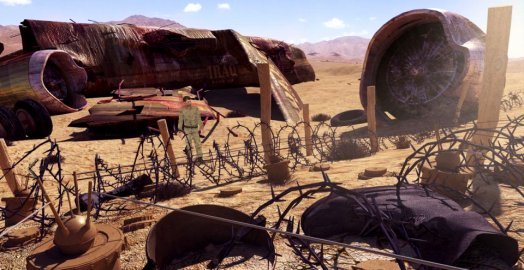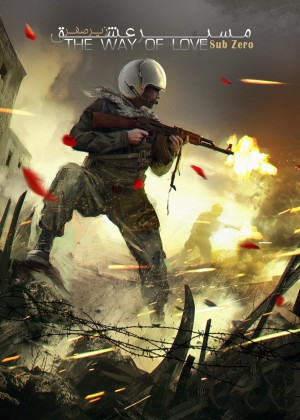Review for The Way of Love: Sub Zero

Story is conflict. And war makes for quite a conflict. It’s odd then that RSK Entertainment’s The Way of Love: Sub Zero, set against the First Persian Gulf War of the 1980s, isn’t particularly about that war. Nor is it about love, or about freezing in any sort of way. Instead, an Iranian pilot is shot down and captured in Iraq while carrying important documents. Now a sole Iranian commando, Rasool Samii Nejad, is being sent in to retrieve the documents and rescue the pilot. It’s a great premise and both the location and historical setting are interesting, so it’s too bad that with its easy puzzles and lack of characterization, this 2.5D point-and-click game makes for a peculiarly empty experience, if not without a bit of charm along the way.
Players first control Rasool as he tries to infiltrate the remote Iraqi al-Bakr garrison to rescue Asef. Beyond the fact that the two men are friends devoted to the Iranian cause, we discover nothing more about these characters, leaving them both ciphers in the game. The compound Rasool needs to infiltrate is set at the intersection of a marsh and desert. With the game spanning afternoon, evening, night, and dawn, there is good variety in the look of the exteriors, even in such a limited geographic region. Whether staring across the dunes, hiding in the tall grass, or moving through rocky canyons, each area is nicely detailed, as are the rugged metal and concrete confines of the garrison itself. 3D characters inhabit the pre-rendered backgrounds, but they tend to pop out, being noticeably less detailed and not lit to match their surroundings.
While there are quite a few scenes to move through overall, many of them serve simply as connecting rooms with nothing to do in them. The game is structured in such a way that at any given time you usually only have three or four rooms available to you, including the empty ones. This makes it a fairly simple process to find the important spots needed to solve the puzzles, though if you do have trouble spotting something, a hotspot highlighter temporarily shows areas of interest. Given that there are typically only one or two puzzles in any particular set of rooms, the obstacles themselves are quite easy. Even so, Rasool sometimes has a tendency to over-explain what needs to be done, such that I felt at times like I was simply completing a grocery list rather than solving things for myself.
Rasool’s descriptions even border on psychic premonitions sometimes. At one point you need to find a way to lure enemy troops away from a communications center. Upon finding the air conditioner unit for the center, Rasool immediately lays out a plan for getting the guards out of the way using items that he doesn’t even know are available, much less have in his possession at that stage. This is not simply the result of playing the game in an unintended order, as it is an extremely linear experience that requires you to do things in a very specific sequence throughout.
Most of the time, the typical rule of collecting everything that’s not bolted down applies here. Rasool even makes comments on occasion when picking up random items that they are likely to come in useful. This makes it odd then when you find the scant few objects that Rasool will initially refuse to take but that you must go back later on to retrieve once you’ve looked at all the other hotspots in the area. On one occasions you find a mirror whose attempted acquisition causes Rasool to question – in a fourth-wall-breaking moment – why you’re wasting your time with it. Then just a few minutes later, when you’ve progressed to the point of needing the mirror, clicking on it again will have Rasool take it with another fourth-wall-breaking comment wondering why you didn’t get it earlier – after all, The Way of Love is the fourth game the developers have made in this loosely-related series (the two Murder in Tehran’s Alleys and Devil in the Capital before it) and you should know by now to take all that arbitrary stuff with you.
Once you’ve collected an item from the environment it’s added to your inventory, which is accessed by moving the mouse to the top of the screen. Left-clicking the item allows you to use it on another there or elsewhere in the current scene. Right-clicking it has Rasool provide a description of the object, typically along with an idea of how specifically it should be used in your current situation. This acts as a sort of informal hint system to make your journey through the Iraqi garrison even easier.
The biggest challenge posed is dodging the various bugs. Here the age-old advice of save early, save often definitely applies as there are several places where glitches can halt you from progressing any further. Early on, I encountered a scene where I had to disable a generator that was powering lights in order to sneak past an Iraqi guard. When I first reached this scene, I saved the game, which promptly caused a key hotspot to go inactive. Reloading the game reactivated the hotspot, which was for a needed inventory item. I employed said item (a pair of wire cutters) in an obvious way, not realizing I had missed another item. Rasool knew I had missed it, and said that before he used the wire cutters it would be good to make sure nothing was forgotten. Unfortunately, the room was a scrollable one but using the wire cutters before picking up the second item prevented the scene from scrolling anymore – and naturally, that object was in the inaccessible part of the room. After another reload I was able to get both items and work towards disabling the generator. Once that was sabotaged, the patrolling Iraqi guard said he was going to go off to get help fixing it. However, his line of dialog got stuck and clicking the mouse to clear it caused the guard to go on patrol again instead of leaving. After one more reload and a replay of the entire sequence, I got lucky and the guard left, allowing me to finally continue. This was the buggiest part of the adventure I encountered, but there were a number of other scenes that were also plagued with technical issues, requiring me to restore a saved game.
Even with having to play several sequences multiple times due to the bugs, I found The Way of Love to be quite a short game, coming in at just under three hours. While easy, I did enjoy sneaking into and through the al-Bakr garrison. Even though there are various guards on patrol, there is nary an actual stealth sequence in sight. Rasool can’t get caught or killed. Getting past the guards is always a matter of puzzle-solving with no manual dexterity to worry about. As you make your way into the compound, your exploits are punctuated by the occasional cinematic. These are done with a hand-painted graphic novel look, making them more stylized than the realistic pre-rendered backdrops. Yet somehow the juxtaposition of these two styles works, such that it doesn’t feel out of place when watching the moodier cutscenes.
It’s hardly a spoiler to say that Rasool’s mission eventually does have him find Asef. At that point the game switches from controlling Rasool to Asef himself as he returns to the Iranian post where he was stationed. Asef is suspicious about having been shot down by the Iraqis and suspects a traitor, so the rest of the game consists of him trying to learn who the traitor is. I say the rest of the game, but really the Asef section is quite short and he only has one suspect from the outset. Almost every one of your actions at this point is punctuated by a cinematic sequence, some of which make rather large story jumps, whereas in the Rasool section the narrative-driving cutscenes are more evenly spaced out. Asef’s part of the game doesn’t have nearly as many things to do as Rasool’s, which makes it feel incomplete and tacked on – especially as the game could have concluded on a satisfying high note at the end of the pilot’s rescue itself. When Asef’s section ends, the game just sort of stops.
Voices are performed in Persian, with Rasool and Asef predominantly talking to themselves (and therefore the player). Only occasionally do they interact with other characters, and even then it’s just a matter of a couple of lines of dialog. While I don’t understand the language, judging by the vocal cadences the acting seems to be fairly well done, although even to my untrained ears there were a few odd-sounding lines where it seemed like suddenly the actor changed. The game is subtitled in English, but it’s not possible to turn the voices themselves off. You can, however, click to advance the dialog once you’re done reading. The script localization is mostly serviceable but won’t win any literary prizes.
The soundtrack is more in the vein of movie music rather than anything appropriately Middle Eastern, but it’s one of the stronger production elements. While there aren’t really any memorable tunes or themes, the simple score does help to convey that feeling of sneaking into a place you shouldn’t be going. It doesn’t quite make you feel like James Bond or Jason Bourne, but it does help set the mood of what you’re clandestinely attempting to do. Sound effects are sporadic and fitting for what they represent – the picking up of keys, the sliding of drawers, and so on – though never a distinguishing feature.
There’s no denying its shortcomings, and yet this game still has a certain charm about it. Although set against the backdrop of a conflict that was characterized by trench warfare, it never really talks about or depicts the horrors of war to any great degree. The focus is much more on the infiltration by a single commando of an enemy garrison. Conducting a military rescue mission is a fairly unusual premise for an adventure game, and the novelty of that concept does help to elevate the experience, at least until it ill-advisedly decides to change course.
Easy. Buggy. Short. All of these characterize The Way of Love: Sub Zero. But with its rather distinct premise, interesting historical setting and stylized cinematics, there is some fun to be had here. They say all’s fair in love and war, and that about sums up The Way of Love: Sub Zero: a fair game that could have been so much more.



_capsule_fog__medium.png)


























